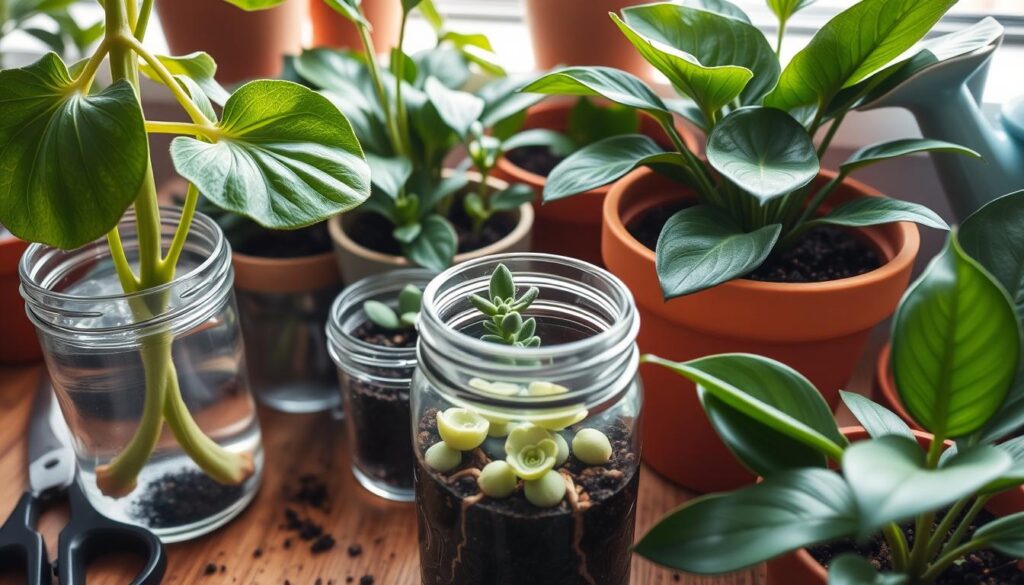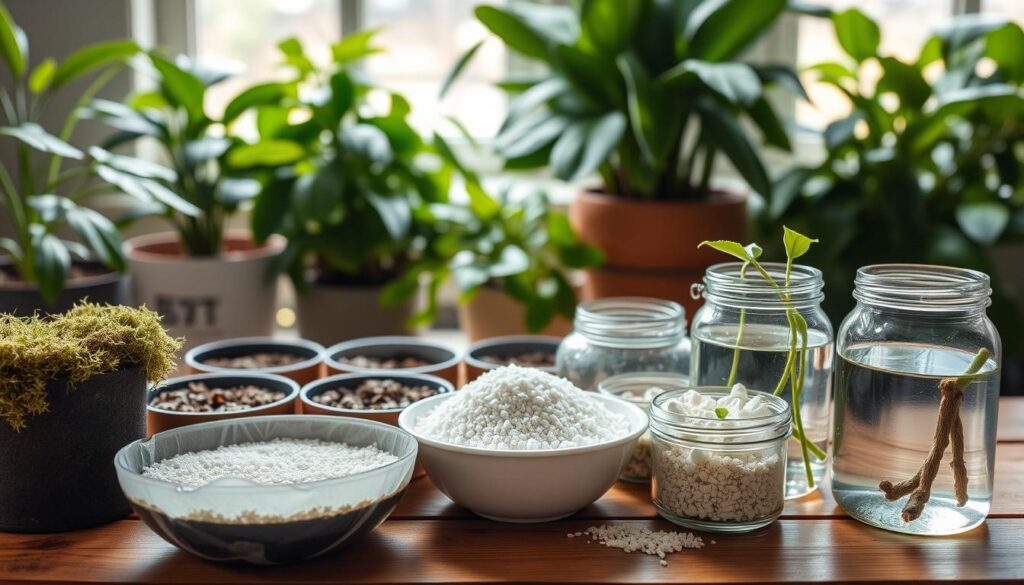Did you know over 50% of indoor plant parents have successfully grown new plants? This shows how popular and easy indoor plant propagation is, even for beginners. In this guide, we’ll show you how to grow more plants from the ones you already have.
Propagation lets you make more plants, making your home look better or giving great gifts. This article will teach you how to do it step by step. You’ll learn to grow more plants and keep your indoor garden healthy.
Key Takeaways
- Indoor plant propagation is an easy and rewarding skill to learn.
- Understanding various propagation methods is essential for success.
- Proper tools and materials are crucial for healthy plant growth.
- Timing and plant health significantly influence propagation outcomes.
- Sharing propagated plants can enhance your indoor plant collection.
What is Indoor Plant Propagation?
Indoor plant propagation is a fun way to grow new plants from old ones. It’s especially interesting for beginners. They can learn to use cuttings, division, and layering to grow more plants.
Understanding the Basics of Propagation
Knowing about indoor plant propagation is key for garden lovers. It’s a rewarding hobby that lets you multiply your plants. It also feels great to see new growth.
It makes gardening more meaningful and fun. You get to connect with nature in a special way.
Benefits of Propagating Indoor Plants
There are many good things about propagating indoor plants. It saves money because it’s cheaper than buying new plants. You can also grow a wide variety of plants that you like.
It’s good for the planet too. It helps reduce waste and brings more life to your space. With the right tips, you can make your home a lush, green oasis.
Types of Indoor Plant Propagation Methods
Exploring the different ways to grow plants indoors can be exciting. Each method is suited for different plants. Knowing these techniques helps you choose the best way to grow your indoor garden.
Cutting Propagation
Cutting propagation is a common method. It involves taking a piece of a plant to start a new one. This method works well for many houseplants, like pothos and succulents.
Division Method
The division method splits a mature plant into sections. Each section can grow into a new plant. It’s great for plants like spider plants and peace lilies. This method also helps prevent the plant from getting too crowded.
Layering Techniques
Layering involves bending a stem to make it grow roots while still attached. It’s perfect for plants like rubber trees. This method is easy and lets the new plant grow slowly while the parent plant stays healthy.
Seed Propagation
Seed propagation is less common but exciting. It lets you grow new varieties from seeds. It takes time and special care, but it’s a unique way to grow plants.
Essential Tools for Successful Propagation
To grow indoor plants well, you need the right tools and materials. Knowing what you need makes the process easier and more successful.
Pruning Shears and Tools
Pruning shears are key for indoor plant propagation. They help make clean cuts, which is good for the plants. You’ll also need a sharp knife and gloves to protect your hands. The right tools make the job easier.
Containers and Soil Requirements
The right containers for propagation are important. Choose ones that drain well to avoid water buildup. Use a mix of potting soil and perlite for the soil. This mix helps keep moisture right for new roots.
Watering and Humidity Considerations
It’s important to know how much water and humidity your plants need. Keep the soil moist but not too wet. Use misting or humidity trays to help.
| Tool | Purpose |
|---|---|
| Pruning Shears | Making clean cuts for propagation |
| Sharp Knife | For precise and delicate cuts |
| Containers | Providing adequate drainage and support |
| Soil Mixture | Ensuring good drainage and nutrient access |
| Humidity Trays | Maintaining moisture levels for rooting |
How to Propagate Common Indoor Plants
Propagating indoor plants is rewarding, especially with easy-to-grow plants. This guide will show you how to propagate common indoor plants. You’ll learn methods that are simple and effective.
Succulents: A Simple Approach
Propagating succulents is easy. You can use leaves or offsets. Here’s how to start:
- Choose a healthy succulent and gently twist off a leaf or cut an offset from the base.
- Let the leaf or offset dry for a couple of days, allowing the cut end to callous.
- Place the calloused end on well-draining soil, lightly misting occasionally.
- After a few weeks, roots will develop, and you will have a new succulent.
Pothos: Tips for Easy Growth
Pothos plants are easy to propagate. Here’s how:
- Cut a healthy stem with 3-4 leaves, ensuring it has at least one node.
- Place the cutting in water or directly into the soil.
- If using water, change it every few days and watch for root growth within a couple of weeks.
- If planted in soil, keep it lightly moist until established.
Spider Plants: Division Techniques
Spider plants produce pups, making division easy. Follow these steps:
- Identify pups that are a few inches long and have their own roots.
- Gently separate them from the main plant using clean scissors.
- Plant the pups in new pots filled with potting soil.
- Water regularly to help them settle, and soon, you’ll have thriving new plants.

Timing Your Propagation Efforts
Getting the timing right is key to successful indoor plant propagation. Understanding the seasons and plant health is crucial. Knowing when to propagate can greatly increase your chances of success, leading to a thriving indoor garden.
Best Seasons for Propagation
The best times for indoor plant propagation are spring and early summer. These seasons offer warmth and light, perfect for growth. Plants are in their active growth phase, making it easier for cuttings or divisions to root well.
As days get longer and temperatures rise, plants naturally rejuvenate. This helps the propagation process.
Recognizing Optimal Plant Health
Checking if your plants are healthy is just as important. Healthy plants have strong leaves and vibrant colors. They have the energy needed for new growth.
Propagating stressed or sick plants usually doesn’t work well. They often lack the strength for successful rooting. Watching your plants grow helps you know when they’re ready for propagation.
Choosing the Right Medium for Propagation
Choosing the right medium is key in propagation. The medium you pick can greatly affect plant growth and success. Each plant has its own needs, making it a challenge but rewarding to find the right medium.
Soil Options for Different Plants
Plants grow best in different soils. Here are some common ones:
- Cacti and Succulents: Need sandy, well-draining soil to avoid root rot.
- Tropical Plants: Do well in a mix that holds moisture, helping with humidity.
- Orchids: Love a bark-based medium for good air circulation.
Water vs. Soil: Which is Best?
There’s a long debate on soil vs water propagation. Knowing the benefits of each can help you decide:
| Method | Advantages | Disadvantages |
|---|---|---|
| Soil Propagation | Provides nutrients, supports roots, and is stable. | Needs specific soils and can hold too much water. |
| Water Propagation | Easy to see root growth; less chance of pests. | Lacks nutrients at first and may struggle to keep plants healthy. |

Caring for Propagated Plants
After you’ve propagated indoor plants, it’s important to care for them well. Make sure to water them right to avoid harming their roots. Also, give them enough light to help them grow strong.
Watering Needs After Propagation
Right after you’ve propagated, it’s key to water them just right. The soil should be moist but not too wet. New plants need water often until their roots get strong.
As they grow, you might need to change how often you water. This depends on things like how humid or hot it is.
- Check soil moisture regularly.
- Water only when the top inch of soil feels dry.
- Use pots with proper drainage to avoid sogginess.
Light Conditions for New Growth
It’s crucial to give new plants the right light. Most prefer bright, indirect sunlight. This helps them grow without getting too stressed.
Direct sunlight can burn their leaves, especially when they’re new.
- Identify a well-lit area with filtered light.
- Gradually expose plants to brighter light as they adjust.
- Rotate pots regularly for even growth.
| Plant Type | Watering Frequency | Light Requirement |
|---|---|---|
| Succulents | Every 2-3 weeks | Bright, indirect light |
| Pothos | Once a week | Moderate to bright indirect light |
| Spider Plants | Weekly | Bright, indirect light |
Troubleshooting Common Propagation Issues
Successful indoor plant propagation needs careful attention and quick action. Spotting diseases and pests early can prevent damage and encourage healthy growth. Knowing what to look for helps gardeners overcome challenges.
Identifying Diseases and Pests
Pests and diseases can slow down plant growth. Look for yellow leaves, stunted growth, or webbing or spots. Aphids and spider mites can quickly harm plants. Regular checks help catch these issues early.
- Check the underside of leaves for pests.
- Monitor for signs of fungal infections.
- Isolate affected plants to prevent spread.
Overcoming Root Rot and Other Problems
Root rot is a big problem in indoor plant propagation. It usually comes from too much water, making roots mushy and decayed. Spotting root rot early can save your plants.
“Prevention is key in stopping root rot before it starts.”
To fix root rot, follow these steps:
- Make sure the soil drains well.
- Use clean tools to avoid spreading infection.
- Don’t overwater; let the soil dry a bit between waterings.
These tips help solve current problems and create better conditions for future growth.
| Common Issues | Symptoms | Solutions |
|---|---|---|
| Pest Infestation | Yellowing leaves, webbing | Insecticidal soap, neem oil |
| Fungal Diseases | Wilting, leaf spots | Improve air circulation, fungicide |
| Root Rot | Smelly soil, mushy roots | Repot with dry medium, cut bad roots |
Successful Indoor Plant Propagation Examples
Indoor plant propagation is both rewarding and educational. Learning from others through successful stories boosts confidence. Real-life examples show different methods and their results.
Each success story highlights the creativity and passion of plant lovers. They share their experiences, showing how to grow plants indoors.
Real-Life Success Stories
Many gardeners have shared their amazing indoor plant propagation journeys. For example, one person turned their home into a green oasis by growing pothos plants. They used cutting techniques, showing how patience and care can lead to success.
- A succulent expert uses water propagation for jade plants, getting amazing results.
- A dedicated gardener grew spider plants through division, expanding their collection.
- Another gardener successfully propagated peace lilies through layering, getting multiple thriving plants.
Lessons Learned from Mistakes
While successful propagation stories inspire, mistakes are part of the journey. Gardeners have faced issues like overwatering or bad soil. These mistakes teach valuable lessons.
Adjusting conditions like light and humidity is key. Learning from mistakes leads to better techniques and results.
These stories and lessons are invaluable to a community of eager gardeners. They show that success is possible, boosting confidence for those starting their journey.
Expanding Your Indoor Plant Collection
As you grow your indoor plant collection, spreading the joy of greenery can be just as fulfilling as nurturing your plants. Expanding your indoor plant collection doesn’t just mean acquiring more plants. It involves sharing the beauty and bounty of your propagation efforts with friends and family.
This practice not only brightens their living spaces but helps foster a community of plant lovers. They can exchange tips, care instructions, and even swap plants.
Gift Ideas for Plant Lovers
When considering gifts for plant lovers, think of starter plants or unique pots to enhance their collection. Personalized potting options, like custom plant markers or beautifully decorated planters, allow you to put a personal touch on your gift. These thoughtful presents can be given on occasions such as birthdays or housewarmings.
Allowing loved ones to start their plant-parenting journey is a great way to show you care.
Sharing Your Propagated Plants
Sharing propagated plants is another excellent way to bond with fellow enthusiasts. Whether it’s a sturdy pothos cutting or a lush spider plant, gifting a piece of your collection can spark new interest. It encourages others to try propagation themselves.
This cycle of sharing propagated plants creates joy and satisfaction. It ensures that both the giver and receiver can grow together in their love of indoor gardening.
FAQ
What is the best method for indoor plant propagation?
The best method depends on the plant type. Cutting propagation is popular for many indoor plants. It’s simple and effective. Always follow proper indoor plant propagation techniques for the best results.
How long does it take to propagate indoor plants?
Propagation time varies widely. Succulents can root in weeks, while others may take months. Proper care during indoor plant propagation steps is key to success.
What tools do I need for indoor plant propagation?
You’ll need clean pruning shears, the right containers, and well-draining soil. The right indoor plant propagation essentials can boost your success.
Can all indoor plants be propagated?
Most indoor plants can be propagated, but methods differ. Some plants take cuttings easily, while others need division or layering. Research the best indoor plant propagation techniques for your plants.
What are some indoor plant propagation tips?
Use clean tools to avoid disease, provide enough humidity, and ensure good lighting. A bit of patience and observation during indoor plant propagation care can help a lot.
How do I care for propagated plants once they start to grow?
Once rooted, monitor watering and provide bright, indirect sunlight. These are crucial for indoor plant propagation care to ensure healthy growth.
What should I do if my propagated plants are not rooting?
Check moisture levels and light conditions if plants aren’t rooting. Adjusting these can often solve the problem. Knowing common indoor plant propagation problems helps in troubleshooting.
How can I propagate plants indoors during winter?
Winter can be tough for propagation due to less light. Use grow lights to supplement natural light. Keep plants in a warm area for optimal growing conditions during indoor plant propagation.
Are there indoor plants that are easier to propagate than others?
Yes, plants like pothos and spider plants are easy to propagate. They can root quickly in water or soil, making them great for beginners looking to try how to propagate indoor plants.


